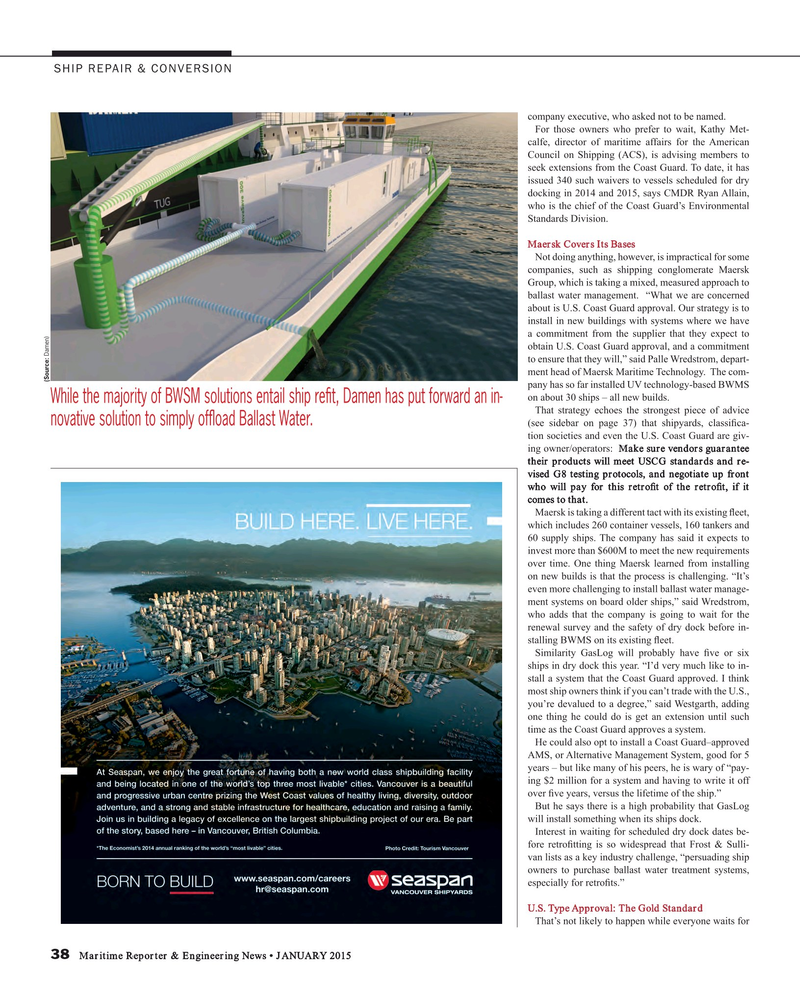
Page 38: of Maritime Reporter Magazine (January 2015)
Ship Repair & Conversion Edition
Read this page in Pdf, Flash or Html5 edition of January 2015 Maritime Reporter Magazine
SHIP REPAIR & CONVERSION company executive, who asked not to be named.
For those owners who prefer to wait, Kathy Met- calfe, director of maritime affairs for the American
Council on Shipping (ACS), is advising members to seek extensions from the Coast Guard. To date, it has issued 340 such waivers to vessels scheduled for dry docking in 2014 and 2015, says CMDR Ryan Allain, who is the chief of the Coast Guard’s Environmental
Standards Division.
Maersk Covers Its Bases
Not doing anything, however, is impractical for some companies, such as shipping conglomerate Maersk
Group, which is taking a mixed, measured approach to ballast water management. “What we are concerned about is U.S. Coast Guard approval. Our strategy is to install in new buildings with systems where we have a commitment from the supplier that they expect to obtain U.S. Coast Guard approval, and a commitment to ensure that they will,” said Palle Wredstrom, depart- ment head of Maersk Maritime Technology. The com- (Source: Damen) pany has so far installed UV technology-based BWMS on about 30 ships – all new builds.
While the majority of BWSM solutions entail ship re? t, Damen has put forward an in-
That strategy echoes the strongest piece of advice novative solution to simply of? oad Ballast Water.
(see sidebar on page 37) that shipyards, classi? ca- tion societies and even the U.S. Coast Guard are giv- ing owner/operators: Make sure vendors guarantee their products will meet USCG standards and re- vised G8 testing protocols, and negotiate up front who will pay for this retro? t of the retro? t, if it comes to that.
Maersk is taking a different tact with its existing ? eet, which includes 260 container vessels, 160 tankers and 60 supply ships. The company has said it expects to invest more than $600M to meet the new requirements over time. One thing Maersk learned from installing on new builds is that the process is challenging. “It’s even more challenging to install ballast water manage- ment systems on board older ships,” said Wredstrom, who adds that the company is going to wait for the renewal survey and the safety of dry dock before in- stalling BWMS on its existing ? eet.
Similarity GasLog will probably have ? ve or six ships in dry dock this year. “I’d very much like to in- stall a system that the Coast Guard approved. I think most ship owners think if you can’t trade with the U.S., you’re devalued to a degree,” said Westgarth, adding one thing he could do is get an extension until such time as the Coast Guard approves a system.
He could also opt to install a Coast Guard–approved
AMS, or Alternative Management System, good for 5 years – but like many of his peers, he is wary of “pay- ing $2 million for a system and having to write it off over ? ve years, versus the lifetime of the ship.”
But he says there is a high probability that GasLog will install something when its ships dock.
Interest in waiting for scheduled dry dock dates be- fore retro? tting is so widespread that Frost & Sulli- van lists as a key industry challenge, “persuading ship owners to purchase ballast water treatment systems, especially for retro? ts.”
U.S. Type Approval: The Gold Standard
That’s not likely to happen while everyone waits for 38 Maritime Reporter & Engineering News • JANUARY 2015
MR #1 (34-41).indd 38 MR #1 (34-41).indd 38 1/7/2015 10:42:27 AM1/7/2015 10:42:27 AM

 37
37

 39
39
